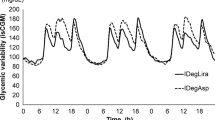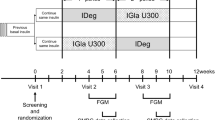Abstract
Background
In general, basal insulin targets fasting plasma glucose (FPG) levels, and prandial insulin targets postprandial glucose (PPG) levels. However, the effects of basal insulin on PPG levels are controversial. We investigated the effect of basal insulin on postprandial hyperglycemia using a test meal at breakfast as well as compared differences between degludec and glargine.
Methods
A total of 20 participants with type 2 diabetes were randomly assigned to degludec (n = 10) or glargine (n = 10). We initiated basal–bolus insulin therapy and titrated only basal insulin until FPG was < 6.1 mmol/L. We evaluated changes in post-breakfast glucose levels and changes in clinical parameters such as serum C-peptide (CPR), proinsulin (PI), and free fatty acids (FFA) levels between the pre- and post-titration periods. Differences between degludec and glargine in the post-titration period were also evaluated.
Results
Post-breakfast glucose levels significantly decreased by 46.1% in the post-titration period compared with the pre-titration period (n = 20, p < 0.001). These decreases correlated positively with decreases in the post-breakfast PI/CPR ratio (r = 0.692, p < 0.001) and in fasting FFA levels (r = 0.720, p < 0.001). There were no significant differences in post-breakfast glucose levels between degludec and glargine. However, the hypoglycemic rate with degludec was significantly lower than with glargine.
Conclusion
Our results suggest that basal insulin with either degludec or glargine decreases the incidence of post-breakfast hyperglycemia accompanied by decreasing the post-breakfast PI/CPR ratio and fasting FFA levels in patients with type 2 diabetes.



Similar content being viewed by others
References
Monnier L, Lapinski H, Colette C. Contributions of fasting and postprandial plasma glucose increments to the overall diurnal hyperglycemia of type 2 diabetic patients: variations with increasing levels of HbA(1c). Diabetes Care. 2003;26:881–5.
Kikuchi K, Nezu U, Shirakawa J, Sato K, Togashi Y, Kikuchi T, Aoki K, Ito Y, Kimura M, Terauchi Y. Correlations of fasting and postprandial blood glucose increments to the overall diurnal hyperglycemic status in type 2 diabetic patients: variations with levels of HbA1c. Endocr J. 2010;57:259–66.
American Diabetes Association. Pharmacologic approaches to glycemic treatment: standards of medical care in diabetes-2020. Diabetes Care. 2020;43:S98–110.
Porcellati F, Lucidi P, Cioli P, Candeloro P, Marinelli Andreoli A, Marzotti S, Ambrogi M, Bolli GB, Fanelli CG. Pharmacokinetics and pharmacodynamics of insulin glargine given in the evening as compared with in the morning in type 2 diabetes. Diabetes Care. 2015;38:503–12.
Wang Z, Hedrington MS, Gogitidze Joy N, Briscoe VJ, Richardson MA, Younk L, Nicholson W, Tate DB, Davis SN. Dose-response effects of insulin glargine in type 2 diabetes. Diabetes Care. 2010;33:1555–60.
Ahmed Saad, Chiara Dalla Man, Debashis K Nandy, James A Levine, Adil E Bharucha, Robert A Rizza, Rita Basu, Rickey E Carter, Claudio Cobelli, Yogish C Kudva, Ananda Bas. Diurnal Pattern to Insulin Secretion and Insulin Action in Healthy Individuals. Diabetes. 2012; 61:2691-700.
Janka HU, Plewe G, Riddle MC, Kliebe-Frisch C, Schweitzer MA, Yki-Järvinen H. Comparison of basal insulin added to oral agents versus twice-daily premixed insulin as initial insulin therapy for type 2 diabetes. Diabetes Care. 2005;28:254–9.
Riddle M, Umpierrez G, DiGenio A, Zhou R, Rosenstock J. Contributions of basal and postprandial hyperglycemia over a wide range of A1C levels before and after treatment intensification in type 2 diabetes. Diabetes Care. 2011;34:2508–14.
Jonassen I, Havelund S, Hoeg-Jensen T, Steensgaard DB, Wahlund PO, Ribel U. Design of the novel protraction mechanism of insulin degludec, an ultralong acting basal insulin. Pharm Res. 2012;29:2104–14.
Atkin Stephen, Javed Zeeshan, Fulcher Gregory. Insulin degludec and insulin aspart: novel insulins for the management of diabetes mellitus. Ther Adv Chronic Dis. 2015;6:375–88.
Heise T, Hoevelmann U, Nosek L, Hermanski L, Bøttcher SG, Haahr H. Comparison of the Pharmacokinetic and Pharmacodynamic Profiles of Insulin Degludec and Insulin Glargine. Expert Opin Drug Metab Toxicol. 2015;11:1193–201.
Monnier L, Colette C, Dunseath GJ, Owens DR. The loss of postprandial glycemic control precedes stepwise deterioration of fasting with worsening diabetes. Diabetes Care. 2007;30:263–9.
Shimoda Seiya, Okubo Mina, Koga Kotaro, Sekigami Taiji, Kawashima Junji, Kukidome Daisuke, Igata Motoyuki, Ishii Norio, Shimakawa Akiko, Matsumura Takeshi, Motoshima Hiroyuki, Furukawa Noboru, Nishida Kenro, Araki Eiichi. Insulin requirement profiles in japanese hospitalized subjects with type 2 diabetes treated with basal-bolus insulin therapy. Endocr J. 2015;62:209–16.
Bailey T, Bode BW, Christiansen MP, Klaff LJ, Alva S. The performance and usability of a factory-calibrated flash glucose monitoring system. Diabetes Technol Ther. 2015;17:787–94.
Yoshiki K, Tomoyuki K, Rie N, Kahori W, Taku T, Fumihiro O, Masaru T, Takafumi A, Masayuki M, Jun-ichiro M, Mitsuyoshi NJ. Comparison of numerical accuracy of personal and professional continuous glucose monitors. Japan Diab. 2015;58:715–20.
Basu A, Basu R, Shah P, Vella A, Johnson CM, Nair KS, Jensen MD, Schwenk WF, Rizza RA. Effects of type 2 diabetes on the ability of insulin and glucose to regulate splanchnic and muscle glucose metabolism: evidence for a defect in hepatic glucokinase activity. Diabetes. 2000;49:272–83.
Kim NH, Kim DL, Choi KM, Baik SH, Choi DS. Serum insulin, proinsulin and proinsulin/insulin ratio in type 2 diabetic patients: as an index of beta-cell function or insulin resistance. Korean J Intern Med. 2000;15:195–201.
Vangipurapu J, Stančáková A, Kuulasmaa T, Kuusisto J, Laakso M. Both fasting and glucose-stimulated proinsulin levels predict hyperglycemia and incident type 2 diabetes: a population-based study of 9,396 Finnish men. PLoS ONE. 2015. https://doi.org/10.1371/journal.pone.0124028.
Pfützner A, Kunt T, Hohberg C, Mondok A, Pahler S, Konrad T, Lübben G, Forst T. Fasting intact proinsulin is a highly specific predictor of insulin resistance in type 2 diabetes. Diabetes Care. 2004;27:682–7.
Fritsche A, Madaus A, Stefan N, Tschritter O, Maerker E, Teigeler A, Häring H, Stumvoll M. Relationships among age, proinsulin conversion, and beta-cell function in nondiabetic humans. Diabetes. 2002;51:S234–9.
Alarcon C, Boland BB, Uchizono Y, Moore PC, Peterson B, Rajan S, Rhodes OS, Noske AB, Haataja L, Arvan P, Marsh BJ, Austin J, Rhodes CJ. Pancreatic β-cell adaptive plasticity in obesity increases insulin production but adversely affects secretory function. Diabetes. 2016;65:438–50.
Laedtke T, Kjems L, Pørksen N, Schmitz O, Veldhuis J, Kao PC, Butler PC. Overnight inhibition of insulin secretion restores pulsatility and proinsulin/insulin ratio in type 2 diabetes. Am J Physiol Endocrinol Metab. 2000;279:E520–8.
Ohta A, Kato H, Murayama K, Hashimoto E, Murakami M, Nishine A, Ohshige T, Sada Y, Asai S, Kawata T, Nagai Y, Katabami T, Tanaka Y. Effect of insulin glargine on endogenous insulin secretion and beta-cell function in Japanese type 2 diabetic patients using oral antidiabetic drugs. Endocr J. 2014;61:13–8.
Ritzel RA, Hansen JB, Veldhuis JD, Butler PC. Induction of beta-cell rest glucose. J Clin Endocrinol Metab. 2004;89:795–805.
Rizzo MA, Magnuson MA, Drain PF, Piston DW. A functional link between glucokinase binding to insulin granules and conformational alterations in response to glucose and insulin. J Biol Chem. 2002;277:34168–75.
Fridlyand LE, Philipson LH. Does the glucose-dependent insulin secretion mechanism itself cause oxidative stress in pancreatic beta-cells? Diabetes. 2004;53:1942–8.
Bravi MC, Armiento A, Laurenti O, et al. Insulin decreases intracellular oxidative stress in patients with type 2 diabetes mellitus. Metabolism. 2006;55:691–5.
Reaven GM, Hollenbeck C, Jeng CY, Wu MS, Chen YD. Measurement of plasma glucose, free fatty acid, lactate, and insulin for 24 h in patients with NIDDM. Diabetes. 1988;37:1020–124.
Hawkins M, Gabriely I, Wozniak R, Reddy K, Rossetti L, Shamoon H. Glycemic control determines hepatic and peripheral glucose effectiveness in type 2 diabetic subjects. Diabetes. 2002;51:2179–89.
Lewis GF, Carpentier A, Adeli K, Giacca A. Disordered fat storage and mobilization in the pathogenesis of insulin resistance and type 2 diabetes. Endocr Rev. 2002;23:201–29.
Shah P, Vella A, Basu A, Basu R, Adkins A, Schwenk WF, Johnson CM, Nair KS, Jensen MD, Rizza RA. Elevated free fatty acids impair glucose metabolism in women: decreased stimulation of muscle glucose uptake and suppression of splanchnic glucose production during combined hyperinsulinemia and hyperglycemia. Diabetes. 2003;52:38–42.
Shulman GI. Cellular mechanisms of insulin resistance. J Clin Invest. 2000;106:171–6.
McGarry JD. Dysregulation of fatty acid metabolism in the etiology of type 2 diabetes. Diabetes. 2002;51:7–18.
Bajaj M, Pratipanawatr T, Berria R, Pratipanawatr W, Kashyap S, Cusi K, Mandarino L, DeFronzo RA. Free fatty acids reduce splanchnic and peripheral glucose uptake in patients with type 2 diabetes. Diabetes. 2002;51:3043–8.
Bachmann OP, Dahl DB, Brechtel K, Machann J, Haap M, Maier T, Loviscach M, Stumvoll M, Claussen CD, Schick F, Häring HU, Jacob S. Effects of intravenous and dietary lipid challenge on intramyocellular lipid content and the relation with insulin sensitivity in humans. Diabetes. 2001;50:2579–84.
Lam TK, Yoshii H, Haber CA, Bogdanovic E, Lam L, Fantus IG, Giacca A. Free fatty acid-induced hepatic insulin resistance: a potential role for protein kinase C-delta. Am J Physiol Endocrinol Metab. 2002;283:E682–91.
Kim JK, Kim YJ, Fillmore JJ, Chen Y, Moore I, Lee J, Yuan M, Li ZW, Karin M, Perret P, Shoelson SE, Shulman GI. Prevention of fat-induced insulin resistance by salicylate. J Clin Invest. 2001;108:437–46.
Shulman GI. Unraveling the cellular mechanism of insulin resistance in humans: new insights from magnetic resonance spectroscopy. Physiology (Bethesda). 2004;19:183–90.
Hawkins M, Tonelli J, Kishore P, Stein D, Ragucci E, Gitig A, Reddy K. Contribution of elevated free fatty acid levels to the lack of glucose effectiveness in type 2 diabetes. Diabetes. 2003;52:2748–58.
Vora J, Christensen T, Rana A, Bain SC. Insulin degludec versus insulin glargine in type 1 and type 2 diabetes mellitus: a meta-analysis of endpoints in phase 3a trials. Diabetes Ther. 2014;5:435–46.
Jakubowicz D, Wainstein J, Ahren B, Landau Z, Bar-Dayan Y, Froy O. Fasting until noon triggers increased postprandial hyperglycemia and impaired insulin response after lunch and dinner in individuals with type 2 diabetes: a randomized clinical trial. Diabetes Care. 2015;38:1820–6.
Author information
Authors and Affiliations
Corresponding author
Ethics declarations
Conflict of interest
Yoshihiko Nishio has received honoraria for scientific lectures from Eli Lilly Japan, Sanofi, and Novo Nordisk Pharma; and received grants/research support from Novo Nordisk Pharma. Kazuma Ogiso, Nobuyuki Koriyama, Takahiko Obo and Akinori Tokito have nothing to disclose.
Human rights statement
All the procedures followed were in accordance with the ethical standards of the responsible committee on human experimentation (National Hospital Organization Kagoshima Medical Center, Ethics Committee, date of approval: 7 May 2015, approval no. 27-6) and with the Helsinki Declaration of 1964 and later versions.
Informed consent
All participants provided written informed consent.
Additional information
Publisher's Note
Springer Nature remains neutral with regard to jurisdictional claims in published maps and institutional affiliations.
Electronic supplementary material
Below is the link to the electronic supplementary material.
About this article
Cite this article
Ogiso, K., Koriyama, N., Obo, T. et al. Basal insulin ameliorates post-breakfast hyperglycemia via suppression of post-breakfast proinsulin/C-peptide ratio and fasting serum free fatty acid levels in patients with type 2 diabetes. Diabetol Int 12, 161–170 (2021). https://doi.org/10.1007/s13340-020-00457-3
Received:
Accepted:
Published:
Issue Date:
DOI: https://doi.org/10.1007/s13340-020-00457-3




